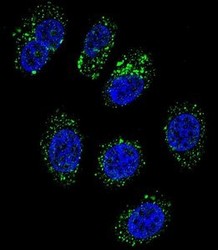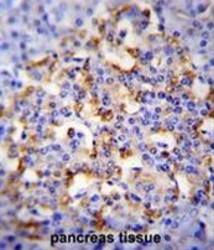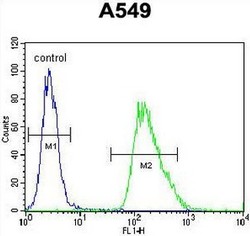Antibody data
- Antibody Data
- Antigen structure
- References [0]
- Comments [0]
- Validations
- Western blot [1]
- Immunocytochemistry [1]
- Immunohistochemistry [1]
- Flow cytometry [1]
Submit
Validation data
Reference
Comment
Report error
- Product number
- AP50981PU-N - Provider product page

- Provider
- Acris Antibodies GmbH
- Proper citation
- Acris Antibodies GmbH Cat#AP50981PU-N, RRID:AB_11145213
- Product name
- anti Chromogranin A (C-term)
- Antibody type
- Polyclonal
- Antigen
- KLH conjugated synthetic peptide between 376-404 amino acids from the C-terminal region of human CMGA
- Reactivity
- Human
- Host
- Rabbit
- Vial size
- 0.4 ml
- Concentration
- 0.5 mg/ml
No comments: Submit comment
Supportive validation
- Submitted by
- Acris Antibodies GmbH (provider)
- Main image

- Experimental details
- CMGA Antibody (C-term) (Cat. #AP50981PU-N) western blot analysis in A549 cell line lysates (35µg/lane).This demonstrates the CMGA antibody detected the CMGA protein (arrow).
Supportive validation
- Submitted by
- Acris Antibodies GmbH (provider)
- Main image

- Experimental details
- Confocal immunofluorescent analysis of CMGA Antibody (C-term)(Cat#AP50981PU-N) with A549 cell followed by Alexa Fluor 488-conjugated goat anti-rabbit lgG (green). DAPI was used to stain the cell nuclear (blue).
Supportive validation
- Submitted by
- Acris Antibodies GmbH (provider)
- Main image

- Experimental details
- CMGA Antibody (C-term) (Cat. #AP50981PU-N)immunohistochemistry analysis in formalin fixed and paraffin embedded human pancreas tissue followed by peroxidase conjugation of the secondary antibody and DAB staining.This data demonstrates the use of CMGA Antibody (C-term) for immunohistochemistry. Clinical relevance has not been evaluated.
Supportive validation
- Submitted by
- Acris Antibodies GmbH (provider)
- Main image

- Experimental details
- CMGA Antibody (C-term) (Cat. #AP50981PU-N) flow cytometric analysis of A549 cells (right histogram) compared to a negative control cell (left histogram).FITC-conjugated goat-anti-rabbit secondary antibodies were used for the analysis.
 Explore
Explore Validate
Validate Learn
Learn Western blot
Western blot